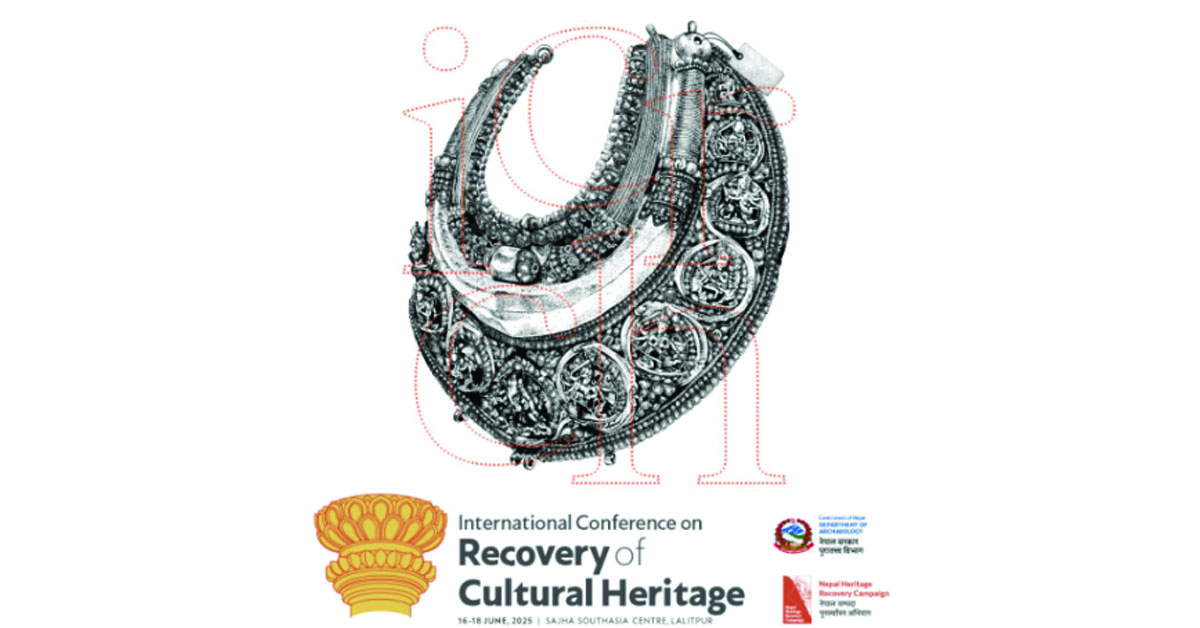
Kathmandu: Building on the growing efforts around the world to track, identify and repatriate stolen cultural properties, the Nepal Heritage Recovery Campaign (NHRC) in collaboration with the Department of Archaeology (DOA), Government of Nepal, is all set to present the International Conference on Recovery of Cultural Heritage taking place from Monday, June 16 through Wednesday, June 18, 2025 at the Sajha Southasia Centre in Lalitpur.
According to the press release, this three-day, in-person global gathering will bring together over 50 experts, heritage advocates, policymakers and community stakeholders from Nepal and around the world to discuss a wide range of connected themes – from the theft and loot and theft of cultural heritage properties from vulnerable regions of the world to the legal frameworks and international policy trends in repatriation.
The aim of this Conference is to bring these discussions in conversation with one another, to critically assess international complexities of cultural patrimony, illicit heritage displacement, and the future of repatriation and ethical stewardship. Through these, the Conference will also explore how the return of stolen heritage contributes to justice, healing, and reconciliation for communities and nations affected by cultural loss.
The Conference will open on 16 June with keynote addresses by Saubhagya Pradhananga, Director-General of the Department of Archaeology, and Erin L. Thompson, Professor of Art Crime at City University of New York (CUNY). The day’s sessions will begin by examining the acquisition and collection of cultural heritage from Nepal, Cambodia, Poland and India. Following this, discussions will turn to the role of the art market—including dealers, auctions and museums. A recurring theme throughout will be the impact of colonial powers and possessions, alongside the persistent efforts of activists, institutions and communities toward repatriation.
The day will conclude with a panel focused on the Taleju Bhawani Temple of Kathmandu, stolen and currently in the collection of the Art Institute of Chicago in the US. There will also be discussion of a painting “King Pratap Malla’s Tuladaan” commissioned by King Pratap Malla in 1664 CE.
The opening keynote on June 17 will be delivered by Amr Al-Azm, Professor of Middle East History and Anthropology at Shawnee State University in Ohio and the Co-Director of the ATHAR Project. Azm is a well-known scholar invested in the story of artefact theft in West Asia. This will then be followed by two parallel sessions, highlighting the state of international legal frameworks for repatriation, digital interventions, heritage in the time of crises, and the critical role of governments.
Another Keynote of the same day will be delivered by lawyers Melina Anotoniadis and Bradley J Gordon who are the driving force behind the return of thousands of looted cultural artefacts to Cambodia. The following sessions will then turn to the topics of advocacy and fractures imposed upon living cultures by heritage theft. The Panelists will then discuss the tangible and intangible heritage of Kathmandu Valley (‘Swoniga’) and beyond, and also how countries such as the United States and Vietnam have responded to illicit trafficking of cultural properties.
Conference Convenor and NHRC Vice-Chair Kanak Mani Dixit says, “We organised this conference because we realised over the past few years that, we had a lot to share about heritage return with the rest of the world, and also a lot to learn from the experience of activists, scholars and administrators elsewhere. Within Nepal, we have to confront the challenge of proving provenance, identifying local thieves and middlemen, the reluctance of communities to welcome back their deities and protect statuary that is returned. Along the way, we have come to realise that intangible cultural heritage requires tangible heritage in order to remain robust.”
The Conference will be complemented by a guided heritage walk on 18 June through Lalitpur’s significant locations for heritage restoration and the visit to the National Museum of Nepal, Chhauni, led by Rishi Amatya, Programme Associate at UNESCO. Since the 1950s, Nepal has lost thousands of cultural artefacts to violent theft, which now sit stripped of their sanctity in museums and collections around the world. The damage has been not just to the architecture and the shrines, but it is also a cut that runs deeper into the folds of communities, ritual lives and identity.
Through this tour, the NHRC aims to ground the Conference’s discussions in reality, offering participants a closer look at the tangible consequences and intangible experiences of cultural plunder. This will be followed by a panel of heritage diplomacy with Pradeep Gyawali, Former Foreign Minister; Jaco du Toit, UNESCO Country Representative; Mike Harker, Acting Deputy Chief of Mission, US Embassy; and Greg Klemm, Deputy Head of Mission, Australian Embassy. The conference will conclude with the signing of Lalitpur Call to International Action. Sunita Dangol, Deputy Mayor of Kathmandu Metropolitan City, will deliver the final address.
Conference and NHRC Director, Alisha Sijapati says, “Heritage repatriation remains a niche issue within the broader field of cultural heritage preservation—one that seldom receives the space it deserves. At our Conference, international voices unite to share their experiences, challenges and triumphs in reclaiming what has been stolen.
This is a significant event for advocacy and knowledge-sharing, where national heritage and identity take centre stage. By bringing together global perspectives, we confront the profound void left by the theft of cultural heritage and explore how this loss resonates differently across countries and communities. This conference serves as a vital platform to examine the intersection of grief, healing and reconciliation—acknowledging that while our experiences of heritage loss may vary, our collective pursuit of justice remains universal.
The Nepal Heritage Recovery Campaign (NHRC) is a non-profit established by activists in 2021 when they united to build on the work of predecessors and develop a coordinated movement to reclaim Nepal’s stolen gods, goddesses, buddhas, bodhisattvas and other representations of our living cultural heritage. The Campaign’s goal is to ensure that, as much as possible, recovered items be returned to their original pedestal, niche, or sanctum.